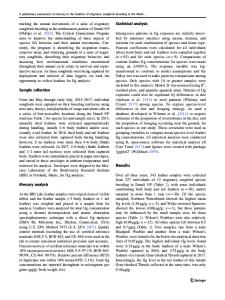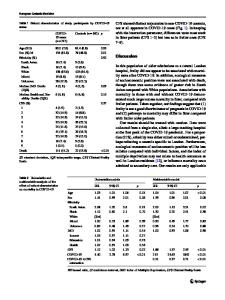Population-specific assessment of carry-over effects across the range of a migratory songbird
- PDF / 1,120,044 Bytes
- 12 Pages / 595.276 x 790.866 pts Page_size
- 5 Downloads / 276 Views
FEATURED STUDENT RESEARCH PAPER
Population-specific assessment of carry-over effects across the range of a migratory songbird Vojtěch Brlík 1,2 & Gintaras Malmiga 3,4 & Dimitar Dimitrov 5 & Tamara Emmenegger 6 & Andrey Gavrilov 7 & Dennis Hasselquist 3 & Strahil Peev 5 & Mikkel Willemoes 3 & Elizabeth Yohannes 8 & Steffen Hahn 6 & Bengt Hansson 3 & Petr Procházka 1 Received: 2 July 2020 / Revised: 28 October 2020 / Accepted: 2 November 2020 # Springer-Verlag GmbH Germany, part of Springer Nature 2020
Abstract Annual cycle events may be interlinked, influence following annual cycle stages, and may alter performance of individuals. Such links, called carry-over effects, can explain individual variation in timing or reproductive success in migratory species. Identifying the key links affecting fitness may reveal the mechanisms of species population dynamics but the current evidence for the strongest carry-over effects is equivocal. Here, we aim to assess the carry-over effects in great reed warblers Acrocephalus arundinaceus, a long-distance migratory songbird, using 103 full-annual tracks from three European and two Asian breeding populations. Our results showed strong positive relationships within autumn and spring migration periods and buffering capacity of the non-breeding period preventing events to carry over between these periods. Moreover, we found no profound relation between the non-breeding habitat quality or seasonality (quantified using stable isotopes and remote sensing data) and the timing of spring migration. The strongest carry-over effects occurred in individuals from the southern European breeding population compared to the northern and the central European populations. A moderate relationship between the habitat seasonality during moult and the spring migration timing indicates the importance of the complete moult. The overall weak carry-over effects of non-breeding habitat conditions found in this study contrast with previous results and imply between-species differences in these crucial relationships. Moreover, the population-specific carry-over effects highlight the importance of multi-population approach and advise caution in interpretation of results from single-population studies. Finally, the carry-over effect from the moulting period indicates the significance of a so-far neglected link in the species. Significance statement Environmental conditions vary in space and time. Therefore, migratory species adjust the timing of migration in order to maximise their fitness. However, the links between annual cycle events in multiple populations and the consequences of environmental conditions outside the breeding range are scarcely known. In this study, we used tracking data of the great reed warbler, an insectivorous bird species breeding across western Eurasia and wintering in Africa, to study a complex system of links between annual events. We found that the strength of these links differed between geographically distinct populations but not between sexes. Moreover, harsh environmental conditi
Data Loading...











